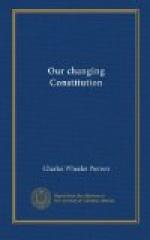How the office has been performed, and whether the constitutional equilibrium is actually being maintained, are the questions to be considered in this book. Before taking them up, however, it will be useful to glance briefly at the Court itself and inquire how it is equipped for its difficult task.
The United States Supreme Court at present is composed of nine judges. The number originally was six. It now holds its sessions at the Capitol in Washington, in the old Senate Chamber which once echoed with the eloquence of the Webster-Hayne debate. The judges are nominated by the President, and their appointment, like that of ambassadors, must be confirmed by the Senate. The makers of the Constitution took the utmost care to insure the independence of the Court. Its members hold office during good behavior, that is to say for life. They cannot be removed except by impeachment for misconduct. Only one attempt has ever been made to impeach a judge of the Supreme Court[1] and that attempt failed. Still further to insure their freedom from legislative control, the Constitution provides that the compensation of the judges shall not be diminished during their continuance in office.[2]
[Footnote 1: Justice Samuel Chase of Maryland in 1804-5.]
[Footnote 2: It is interesting to observe that this Court, safeguarded against popular clamor and composed of judges appointed for life, has consistently shown itself more progressive and more responsive to modern ideas than have most of the state Supreme Courts whose members are elected directly by the people and for limited terms only.]
From the time of John Jay, the first Chief Justice, down to the present day the men appointed to membership in the Court have, for the most part, been lawyers of the highest character and standing, many of whom had already won distinction in other branches of the public service. The present Chief Justice (Taft) is an ex-President of the United States. Among the other members of the Court are a former Secretary of State of the United States (Justice Day); two former Attorneys General of the United States (Justices McKenna and McReynolds); a former Chief Justice of Massachusetts (Justice Oliver Wendell Holmes, the distinguished son and namesake of an illustrious father); a former Chief Justice of Wyoming (Justice Van Devanter); and a former Chancellor of New Jersey (Justice Pitney).
It is well that the personnel of the Court has been such as to command respect and deference, for in actual power the judiciary is by far the weakest of the three cooerdinate departments (legislative, executive, judicial) among which the functions of government were distributed by the Constitution. The power of the purse is vested in Congress: it alone can levy taxes and make appropriations. The Executive is Commander-in-Chief of the Army and Navy and wields the appointing power. The Supreme Court controls neither purse nor sword nor appointments to office. Its power is moral rather than physical. It has no adequate means of enforcing its decrees without the cooeperation of other branches of the Government.




